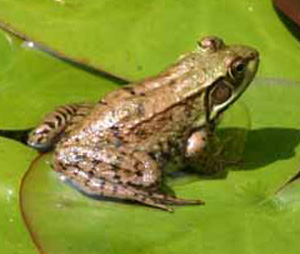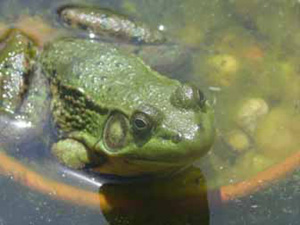Northern Green Frog & Southern Green Frog
Rana pipiens - Rana sphenocephala
Natives of North America, Green frogs are green or greenish brown with creamy white undersides for females and yellow for males. They are typically green with a transition to brown, black marks dot the brown area of the frog. Two distinct ridges run down the back, from the eyes to the tail - this helps differentiate the green frog from immature bullfrogs. Occasionally unspotted green frogs occur.
Like all true frogs, green frogs have smooth moist skin and glandular ridges (dorsolateral folds) that separate the back from the sides of the body (the ridges in green frogs form the lines seen on the back of the frog that  do not reach the frog's groin). The hind legs are long with large feet and well developed webs between the toes. do not reach the frog's groin). The hind legs are long with large feet and well developed webs between the toes.
These frogs can be kept in small groups. They are suitable for beginners.
We have a small man made pond in our backyard which a male green frog has adopted. This is year number 3 for it and its song (croaking) is from morning till late night. We keep these frogs wild and have avoided "domesticating" them. It is interesting to hear them croaking in the flower beds we have surrounding the pond while they hunt bugs. If you want to keep these frogs as pets, check your local regulations about taking wild animals. Once inside, keep them away from all other amphibian/reptile pets until you have adequately quarantined it and treated the "new pet" for internal parasites.
DO NOT FEED WILD INSECTS OR INSECTS FOUND AROUND THE HOUSE – THEY MAY CARRY DISEASES AND PESTICIDES THAT COULD BE DEADLY TO YOUR PET
Average Size - approximately 2 1/8 - 4 inches
Life Span - approximately 5-8 years
Diet - crickets, wax worms, fly larvae, and earthworms.
Feeding - A meal of 3-4 crickets daily is a good starting point, although some experts recommend feeding mature frogs only every other day. Variety seems to be key with frogs - crickets can make up the bulk of the diet but should be supplemented by a variety of other insects and worms. Prey items should be gut loaded (feed nutritious foods such as fruits, vegetables, dog food, fish food etc.) before being given to the frog. Once weekly dust the crickets with a complete reptile vitamin mix.
Housing - A ten gallon tank is sufficient for a single frog (if keeping more frogs the tank size must increase, keeping in mind that floor space is more important than height). Green frogs are semi aquatic and need a land area as well as a large enough body of water that they can submerge their bodies. A half land/half water tank is a good choice for green frogs and these can be set up a number of ways It is easiest in the long term to separate the land and water areas with a piece of plastic or Plexiglas placed across the aquarium and sealed with aquarium grade silicone sealant. This allows the use of soil on the terrestrial side to allow the frogs to burrow. A dense piece of wood (e.g. driftwood) can be placed partly in the water and partly on land to provide an easy transition from water to land (this also provides a nice basking spot). Alternately, gravel can be sloped in the aquatic side to provide a ramp out of the water.
Substrate - a combination of soil and peat moss, covered with a commercial reptile bark substrate and sphagnum moss can be used on the terrestrial side. The depth should be at least 2-3 inches to allow burrowing. Gravel can be used on the aquatic side. It is extremely important to use smooth gravel only (to prevent skin abrasions and injuries), and ideally the gravel should be large enough not to be swallowed.
Temperature - the tank can be kept at room temperature 68-75 F, although a temperature drop at night is a good idea (down to about 60 F).
Lighting - No special lighting is required. You can use a UVA/UVB fluorescent light which may be beneficial. Just make sure the frog can't jump onto the lamp. Avoid making the enclosure too bright however as the frogs may just hide if the tank is very brightly lit. A light cycle of about 10 hours light to 14 hours dark is recommended by some keepers.
Water - the water used must be dechlorinated. Use a product from the pet store designed to remove chorine (and chloramine, if your water supply is treated with chloramine) to be safe. Filtration is not a necessity, but doing a 50% water change on a regular basis (at least twice weekly, perhaps more) is necessary. (In fact, some experts believe that the constant water vibrations from the filter is a sensory overload to frogs).
Recommended Supplies:
- Habitat with secure lid
- Basking rock or log
- Humidity gauge
- Substrate/commercial mulch
- Book about frogs
|
- Canister filter
- Fish net or scoop
- Incandescent light or ceramic heater
- Thermometer
- Vitamin/mineral supplement
|
Habitat Maintenance Change at least 1/2 the water twice weekly. Thoroughly clean the tank at least once  week: set frog aside in a secure habitat; scrub the tank and furnishings with a 3% bleach solution; rinse thoroughly with water, removing all smell of bleach; dry the tank and furnishings; and add clean substrate week: set frog aside in a secure habitat; scrub the tank and furnishings with a 3% bleach solution; rinse thoroughly with water, removing all smell of bleach; dry the tank and furnishings; and add clean substrate
Grooming and Hygiene Don't handle unless necessary; wear latex gloves; do not allow frog's skin to contact with eyes, mouth, or open wounds. Wash your hands after handling the habitat contents to help prevent Salmonella and other infectious diseases.
Determining the sex of green frogs - The shape of the tympanic membranes, the circles that are where the “ears” should be can help determine the sex of a green frog. Females and males have differently shaped ears (tympanic membranes). In males the tympanum is clearly larger than the eye, while in females it is about the same size. The males in this species also have a yellow throat, in females it is white like the belly.
Signs of a Healthy Pet:
- Active and alert
- Healthy skin
- Clear eyes
|
- Eats regularly
- Clear nose and vent
- Hopping and swimming
|
Common Health Issues and Red Flags:
- Lethargy
- Skin lesions
- Loss of appetite
- Distressed breathing
|
- Weight loss
- Weak leg movements
- Bloated abdomen
|
If you notice any of these signs, please contact your exotic animal veterinarian.
As with all pets in this category, it is important that you find a veterinarian that practices in EXOTICS – this is critical. The typical small animal practitioner may not have sufficient knowledge in this area. Even this guide is general in nature and should not be used to diagnose your pet.
|


 do not reach the frog's groin). The hind legs are long with large feet and well developed webs between the toes.
do not reach the frog's groin). The hind legs are long with large feet and well developed webs between the toes. week: set frog aside in a secure habitat; scrub the tank and furnishings with a 3% bleach solution; rinse thoroughly with water, removing all smell of bleach; dry the tank and furnishings; and add clean substrate
week: set frog aside in a secure habitat; scrub the tank and furnishings with a 3% bleach solution; rinse thoroughly with water, removing all smell of bleach; dry the tank and furnishings; and add clean substrate